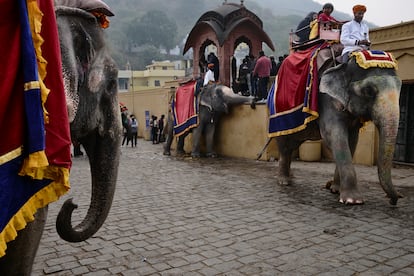Stressed and sleep-deprived elephants: the sacred animal succumbs to tourist pressure in India

Traffic grinds to a halt near Amber Fort , the palatial complex in the city of the same name, 11 kilometers from Jaipur (Rajasthan state, northern India), as a chorus of horns announces the arrival of a line of elephants. They weave their way through the tuk-tuks , their trunks and eyes adorned with bridles and brightly colored paint. At this hour, the sun beats down, and the animals are returning to their sanctuaries after a day's work. Each one carries on its back its mahout , the handler who has been with it since infancy.
For centuries, the elephant has been a sacred symbol in India, home to the world's largest population of these Asian pachyderms, numbering around 27,000, scattered throughout the country. Their living conditions vary greatly from state to state. In the south, in regions like Kerala, wild populations can still be found in the forests, while in more northerly areas, such as Rajasthan, elephants live only in captivity, in protected sanctuaries : places that provide refuge for injured animals or those rescued from poachers. Although the sanctuaries were initially conceived to protect the species and promote local traditions and culture, they have since become the cornerstone of a thriving but controversial tourism industry. At Amber Fort alone, some 125 elephants carry hundreds of visitors to the top of the complex every day. Across the country, it is estimated that there are between 2,700 and 3,500 elephants in captivity, and more than 75% of them participate in tourist activities.
Defining elephants as 'domesticated' is misleading: it simplifies their situation and distorts their biological reality.
World Animal Protection
According to the Rajasthan government's 2024-2025 Economic Report , tourism accounts for approximately 15% of the state's GDP. This demand has fueled a proliferation of centers offering tours, body painting, and animal feeding. However, this growth has come at a cost.

“Defining elephants as 'domesticated' is misleading: it simplifies their situation and distorts their biological reality,” warns the World Animal Protection (WAP) report , Elephants Not Commodities . Although they live in contact with humans, they retain the behaviors and instincts of wild species. “Talking about domestication masks a very different process: training to ensure the animal’s obedience,” the organization points out.
Lack of regulationIn Rajasthan, elephants live exclusively in captivity, housed in sanctuaries created to rescue injured or poached animals. But not all of them meet the same standards. As Geeta Seshamani, co-founder and secretary of Wildlife SOS , explains, some are true sanctuaries, committed to providing natural spaces and humane conditions, while others operate as tourist attractions. “Many facilities lack the necessary space and equipment to encourage the exploratory and social behavior typical of elephants,” which leads “to joint problems due to both immobility and the excessive strain imposed in captivity,” the activist continues. She adds: “Without proper regulation, and with the ever-increasing demand, it will become increasingly difficult to distinguish truly ethical centers from those driven by market forces.”
Several academic studies and field observations show that some elephants live in appalling conditions: sleep and nutrition imbalances, isolation, and discomfort due to the continuous use of sticks and rigid saddles ( howdahs ). These factors jeopardize the elephants' physical and, often, psychological well-being. In many cases, captive elephants continue to exhibit stereotypical behaviors—such as compulsive rocking or repetitive movements—clear symptoms of stress and frustration.
These elephants have attacked humans or other elephants out of pure frustration, stemming from being used for riding.
Khushboo Gupta, advocacy projects director at PETA India
A clear example is that of Malti, an elephant who worked for years at Amber Fort and was moved to a sanctuary after a long campaign by PETA India, an organization dedicated to protecting elephants in the area. “A group of 120 veterinarians signed a document stating that the elephant was suffering psychologically. It was necessary to rehabilitate her and move her to a specialized care center,” recalls Khushboo Gupta, advocacy projects director at PETA India. The organization denounced the abuse she suffered during her captivity and the lack of veterinary care.
Other elephants have also shown signs of suffering that have sometimes led to aggressive reactions: in 2024, the elephant Gouri was filmed attacking a tourist, reigniting the debate about the limits of forced coexistence between humans and animals . “These elephants have attacked humans or other elephants out of sheer frustration, stemming from being used for riding,” explains Gupta.
The link with the 'mahouts'Another factor to consider in elephant protection is their relationship with mahouts. Although tradition holds that this is a symbiotic or spiritual bond, it is based on training that often employs invasive practices passed down through generations and driven by economic necessity: for many mahouts , caring for elephants is their only source of income.
“Some 15,000 people depend on the village’s 65 elephants,” explains Ballu Khan, chairman of the Elephant Village Development Committee in Jaipur. “To make matters worse, the ride fee has been reduced by about 1,500 rupees [almost 15 euros], but the owner only receives 1,200. This is a serious problem for the mahouts , who, despite everything, continue to dedicate themselves to caring for their elephants.”
Kumar, a young mahout who works at a sanctuary near Jaipur, describes the daily routine of Padma, a 35-year-old elephant: “Every day she consumes about 260 kilos of food: 200 of sugarcane, 20 of sorghum , 15 of green fodder, 10 of watermelon, 10 of bananas, and 5 of wheat rotis at night.” The daily cost of feeding her exceeds 4,000 rupees. “Balancing that expense with family needs and such limited income is becoming increasingly difficult. My family has been doing this for generations, but it has never been so hard to make ends meet,” he laments. “In recent years, more sanctuaries have sprung up here in southern Rajasthan, and in my opinion, that increase—not only in demand but also in supply—has put our work in crisis.”
The legal framework also influences the status of elephants. In 2021, a committee of experts declared 10 elephants in Jaipur unfit for rides, and the state government ordered their removal. “We applaud the measures taken by the government to stop the use of some older or sick animals,” Gupta acknowledges.
However, the most recent reforms have raised concerns. Amendments to the Wildlife Protection Act of 2022 and the implementation in 2024 of the Rules for the Transfer of Captive Elephants have broadened the grounds for keeping elephants in captivity, including for religious and cultural purposes. According to PETA India, these changes facilitate transfers between states and blur the line between conservation and exploitation.
“Elephants are the only wild animals that private individuals can own. Although the law prohibits their sale, they continue to be traded commercially under the guise of gifts or donations,” Gupta denounces. “In the name of tourism, we are turning a national symbol into an attraction. At what cost?” he asks.
EL PAÍS





